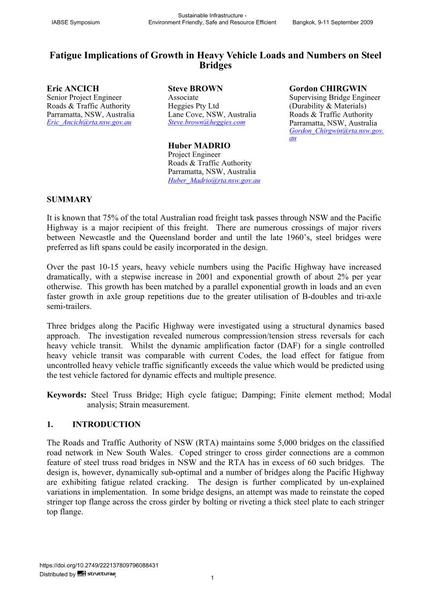Fatigue Implications of Growth in Heavy Vehicle Loads and Numbers on Steel Bridges

|
|
|||||||||||
Détails bibliographiques
| Auteur(s): |
Eric Ancich
Steve Brown Gordon Chirgwin Huber Madrio |
||||
|---|---|---|---|---|---|
| Médium: | papier de conférence | ||||
| Langue(s): | anglais | ||||
| Conférence: | IABSE Symposium: Sustainable Infrastructure - Environment Friendly, Safe and Resource Efficient, Bangkok, Thailand, 9-11 September 2009 | ||||
| Publié dans: | IABSE Symposium Bangkok 2009 | ||||
|
|||||
| Page(s): | 11-44 | ||||
| Nombre total de pages (du PDF): | 34 | ||||
| Année: | 2009 | ||||
| DOI: | 10.2749/222137809796088431 | ||||
| Abstrait: |
It is known that 75% of the total Australian road freight task passes through NSW and the Pacific Highway is a major recipient of this freight. There are numerous crossings of major rivers between Newcastle and the Queensland border and until the late 1960’s, steel bridges were preferred as lift spans could be easily incorporated in the design. Over the past 10-15 years, heavy vehicle numbers using the Pacific Highway have increased dramatically, with a stepwise increase in 2001 and exponential growth of about 2% per year otherwise. This growth has been matched by a parallel exponential growth in loads and an even faster growth in axle group repetitions due to the greater utilisation of B-doubles and tri-axle semi-trailers. Three bridges along the Pacific Highway were investigated using a structural dynamics based approach. The investigation revealed numerous compression/tension stress reversals for each heavy vehicle transit. Whilst the dynamic amplification factor (DAF) for a single controlled heavy vehicle transit was comparable with current Codes, the load effect for fatigue from uncontrolled heavy vehicle traffic significantly exceeds the value which would be predicted using the test vehicle factored for dynamic effects and multiple presence. |
||||
